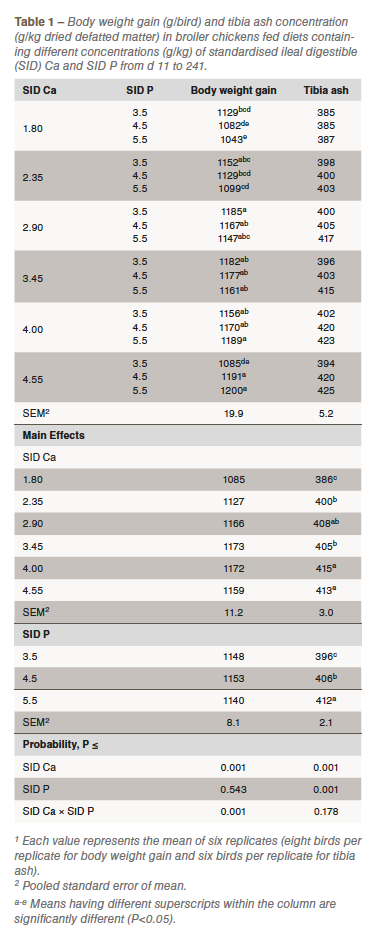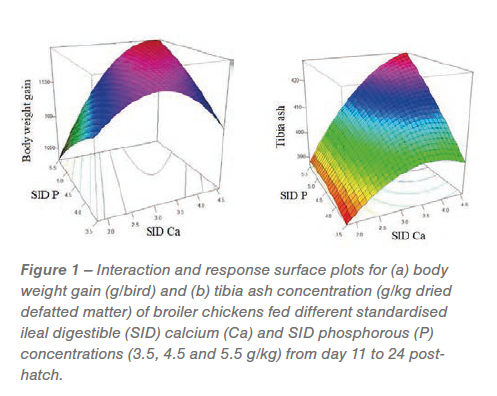
An experiment was conducted to determine the digestible calcium (Ca) and digestible phosphorus (P) requirements of 11-24 days old broiler chickens.
L.S. David1, M.R. Abdollahi1, G. Ravindran2, M.R. Bedford3 and V. Ravindran1
1 Monogastric Research Centre, School of Agriculture and Environment, Massey University, Palmerston North 4442, New Zealand
2 Institute of Food, Nutrition and Human Health, Massey University, Palmerston North 4442, New Zealand
3 AB Vista, Marlborough, Wiltshire SN8 4AN, United Kingdom
Eighteen experimental grower diets based on maize-soybean meal were formulated in a 6 × 3 factorial arrangement with diets containing six concentrations of standardised ileal digestible (SID) Ca (1.80, 2.35, 2.90, 3.45, and 4.55 g/kg) and three concentrations of SID P (3.5, 4.5 and 5.5 g/kg) and were fed to broilers from days 11 to 24. Each experimental diet was randomly allocated to six replicate cages (eight birds per cage). Body weight was recorded on day 11 and 24. On day 24, the birds were euthanised to collect tibia for the determination of tibia ash concentrations. Fixed effects of the experiment were dietary concentrations of SID Ca and SID P and their interaction. If the interaction or main effects were significant (P < 0.05), the parameter estimates for second- order response surface model were determined using General Linear Model procedure of SAS (2019). The body weight gain of broiler growers was found to be optimised at the SID P concentrations of 3.5 g/kg at SID Ca concentrations below 4.0 g/kg. At 3.5 g/kg SID P concentration, the required SID Ca for maximum weight gain was determined to be 3.05 g/kg, which corresponded to SID Ca to SID P ratios of 0.87. The concentration of SID Ca that maximised tibia ash at 3.5 g/kg SID P was 3.69 g/kg, which corresponded to SID Ca to SID P ratio of 1.05. Bone ash requires more Ca than body weight gain.
Introduction
Poultry diets are currently formulated based on total calcium (Ca) and available phosphorus, with a ratio of 2:1 being maintained between them. For a number of reasons, there is increasing interest in shifting the formulations based on digestible Ca and digestible P. To enable this move, information is required of the requirements of digestible Ca and digestible P. A recent study at our laboratory (David et al., 2021) determined the standardised ileal digestible (SID) Ca and SID P requirements for broiler starters (day 1-10 posthatch). The results showed that the weight gain, tibia ash, and Ca and P utilisation were optimised at 5 g/kg SID P concentration. The SID Ca required for maximum weight gain and tibia ash at 5 g/kg SID P was determined to be 3.32 and 4.51 g/kg, respectively, which corresponded to SID Ca to SID P ratios of 0.66 and 0.90, respectively. The objective of the current study was to determine the requirements of digestible Ca and digestible P in broiler growers (days 11-24 posthatch) to maximise weight gain and tibia ash.
Materials and method
The experimental protocol was approved by the Massey University Animal Ethics Committee. Eighteen experimental grower diets based on maize-soybean meal were formulated in a 6 × 3 factorial arrangement with diets containing six concentrations of Ca and three concentrations of P. Diets were formulated to contain 1.80, 2.35, 2.90, 3.45, 4.00 and 4.55 g/kg SID Ca (corresponding to 3.8, 4.8, 5.8, 6.8, 7.8 and 8.8 g/kg total Ca, respectively) and 3.5, 4.5 and 5.5 g/kg SID P (corresponding to 4.7, 6.2 and 7.7 g/kg total P, respectively). A total of 864, day-old male broilers (Ross 308) were fed broiler starter crumbles till day 10. On day 11, the birds were weighed and allocated (mean ± SD, 383 ± 11.2 g) to 108 grower cages (eight birds per cage). The experimental diets were offered ad libitum to six replicate cages of broilers from day 11 to 24 post-hatch. The birds had free access to water. Body weight was recorded on a cage basis at the start and end of the experimental period and the weight gain was calculated. On day 24, right tibia from six birds per replicate was removed and processed as described by David et al. (2021). The tibia ash concentration was determined using AOAC (2016) procedures. Data were analysed using the General Linear Model (GLM) procedure of SAS (2019), with cage serving as the experimental unit. Two sets of analyses were conducted. First, as a factorial arrangement of treatments examining the effects of dietary concentrations of SID Ca and SID P and their interaction. The effects were considered significant at P<0.05. Second, if the interaction or main effects were significant, then the estimates for the second-order response surface model were determined using the GLM procedure of SAS (2019) and these estimates were used to calculate the maximum response and the SID Ca concentration required for maximum response.
Results and discussion
All birds remained healthy during the experiment. Table 1 and Figure 1 present the body weight gain and the concentrations of tibia ash of 11 to 24-day old birds fed the diets containing different SID Ca and SID P. 
There was an interaction (P<0.001) between SID Ca and SID P for body weight gain. At the lowest SID Ca (1.80 g/kg) concentration, increasing concentration of SID P reduced body weight gain. However, increasing SID P concentration increased body weight gain at the highest SID Ca concentration (4.55 g/kg), but did not affect the gain at other SID Ca concentrations (2.35 and 4.00 g/kg), demonstrating that the gains were increased with increasing SID P if the SID Ca was also increased (4.55 g/kg) beyond 4.00 g/kg. To predict the SID Ca at maximum response, a reduced model was used for body weight gain. The predicted maximum body weight gains at SID P concentrations of 3.5, 4.5 and 5.5 g/kg were 1174, 1177 and 1200 g/bird, at SID Ca concentrations of 3.05, 3.69 and 4.33 g/kg, respectively. These values corresponded to SID Ca to SID P ratios of 0.87, 0.82 and 0.79, respectively. Based on the current finding and at SID Ca concentrations below 4.0 g/kg, the SID P concentration of 3.5 g/kg is recommended for broiler growers (11-24 day post-hatch). The concentration of SID Ca that maximised body weight gain at 3.5 g/kg SID P was 3.05 g/kg, which corresponded to SID Ca to SID P ratio of 0.87. This estimate is lower than the current Ross (2019) total Ca recommendation for broiler growers (8.7 g/kg total Ca or 4.47 g/kg SID Ca) and that reported for broiler starters (David et al., 2021) for weight gain (3.32 g/kg SID Ca). Digestible Ca requirements between 4.5-5.4 g/kg have been proposed by Angel (2018) for 11 to 24 day old broilers, but experimental details for this recommendation were not provided. Based on factorial arrangement of treatments, there was no interaction (P>0.05) between SID Ca and SID P for the tibia ash. Tibia ash was increased (P<0.05) by increasing concentrations of both SID Ca and SID P. As expected, the highest concentration of both SID P (5.5 g/kg) and SID Ca of 4.0 g/kg and above increased the concentration of tibia ash, which is in agreement with the previous finding (David et al., 2021). To predict the SID Ca at maximum response, a reduced model was used for tibia ash. The predicted maximum tibia ash at SID P concentrations of 3.5, 4.5 and 5.5 g/kg were 401, 413 and 428 g/kg, at SID Ca concentrations of 3.69, 4.30 and 4.91 g/kg, respectively. These values corresponded to SID Ca to SID P ratios of 1.05, 0.96 and 0.89, respectively. Based on the current findings, required SID P concentration for the optimum tibia ash at SID Ca concentrations below 4.0 g/kg was 3.5 g/kg. The concentration of SID Ca that maximised tibia ash at 3.5 g/kg SID P was 3.69 g/kg, which corresponded to SID Ca to SID P ratio of 1.05. This estimate is lower than the current Ross (2019) total Ca recommendation for growers (8.7 g/kg total Ca or 4.47 g/kg SID Ca) and that reported for broiler starters (David et al., 2021) for tibia ash (4.51 g/kg SID Ca), demonstrating a reduction of 18% in SID Ca requirement in growers compared to broiler starters.
Based on factorial arrangement of treatments, there was no interaction (P>0.05) between SID Ca and SID P for the tibia ash. Tibia ash was increased (P<0.05) by increasing concentrations of both SID Ca and SID P. As expected, the highest concentration of both SID P (5.5 g/kg) and SID Ca of 4.0 g/kg and above increased the concentration of tibia ash, which is in agreement with the previous finding (David et al., 2021). To predict the SID Ca at maximum response, a reduced model was used for tibia ash. The predicted maximum tibia ash at SID P concentrations of 3.5, 4.5 and 5.5 g/kg were 401, 413 and 428 g/kg, at SID Ca concentrations of 3.69, 4.30 and 4.91 g/kg, respectively. These values corresponded to SID Ca to SID P ratios of 1.05, 0.96 and 0.89, respectively. Based on the current findings, required SID P concentration for the optimum tibia ash at SID Ca concentrations below 4.0 g/kg was 3.5 g/kg. The concentration of SID Ca that maximised tibia ash at 3.5 g/kg SID P was 3.69 g/kg, which corresponded to SID Ca to SID P ratio of 1.05. This estimate is lower than the current Ross (2019) total Ca recommendation for growers (8.7 g/kg total Ca or 4.47 g/kg SID Ca) and that reported for broiler starters (David et al., 2021) for tibia ash (4.51 g/kg SID Ca), demonstrating a reduction of 18% in SID Ca requirement in growers compared to broiler starters.
In conclusion, the requirements of SID Ca, SID P and their ratio for broiler growers were determined. Accordingly, required SID P for the weight gain and tibia ash of 11-24 day old broilers at SID Ca concentrations below 4.0 g/kg is 3.5 g/kg. At 3.5 g/kg SID P, weight gain and tibia ash are maximised at 3.05 and 3.69 g/kg SID Ca concentrations, respectively.
References
Angel CR (2018) Proceedings of the Asia Pacific Poultry Conference 11: 43-51.
AOAC (2016) Official Methods of Analysis, 20th ed. Association of Official Analytical Chemists, Washington, DC.
David LS, Abdollahi MR, Bedford MR & Ravindran V (2021) Poultry Science. DOI: 10.1016/j.psj.2021.101439.
Ross (2019) Ross 308 Broiler: Nutrition Specification, Aviagen. Huntsville, AL.
From the Proceedings of the Australian Poultry Science Symposium 2022

















